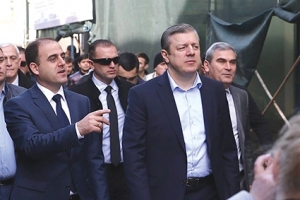‘New Tiflis’ to Bring Tourism, Economic and Social Benefits
The Government of Georgia announced the start of the first stage of the large-scale restoration-rehabilitation works on the David the Builder (Agmashenebeli) Avenue and Dry Bridge surrounding area, which are among the oldest districts of Tbilisi. By the end of the year, 45 residential buildings will be completely rehabilitated; and parks and pedestrian zones will be introduced, alongside new tourist spots and facilities.
According to the ‘New Tiflis’ project, along the second half of the David the Builder Avenue – from Marjanishvili Square to Zaarbriuken Square (former Voroncov Square) – the Avenue will be completely transformed into a pedestrian zone which will include cafes, shops, renewed gardens and tourist routes.
Mayor of Tbilisi, Davit Narmania, highlighted that the project will bring social and economic benefits. “First of all, we care about our citizens and it is important for us to make their social condition more comfortable and give them rehabilitated buildings. At the same time, the majority of buildings in this district are cultural heritage, dating back to the 19th century; after the renovation, the price of real estate here will also become more attractive and interesting from an economic point of view,” Narmania said.
The Mayor noted that the new project is also to affect the surrounding areas of Dry Bridge – the 9 March and the Dedaena gardens will be connected with an underground pedestrian passage, where a gallery, shops and other tourist zones will be installed. The David the Builder Avenue and Dry Bridge, which are already among the top tourist destinations in Tbilisi, will become even more attractive.
Moreover, the Prime Minister of Georgia, Giorgi Kvirikashvili, highlighted the ecological problems in the city and stated that the government is going to recover the so called German gardens in the district according to 19th century’s maps. “We will increase the number of green zones in the city. It is highly important to balance while we have such heavy traffic. People will have more places for rest, and the gardens will have a positive effect on the environment,” Kvirikashvili said.
The government spent 21 million Lari on the first phase of the ‘New Tiflis’ project. In order to preserve the city center’s historic appearance, more than 200 architects and engineers worked in tandem with historians, art historians, restoration specialists and urban planners. After the project implementation by the end of 2016, it is expected that even more job places will be created.
“We need to breathe new energy into the city,” said the Prime Minister at the ‘New Tiflis’ presentation. “Tbilisi is a special city in its architecture and location. It is our duty to recover the heritage that as given us. We need to develop tourism and the economy. The city should give hope to residents and create more job places. Moreover, Tbilisi should become an even more interesting and attractive destination for tourists.”
Eka Karsaulidze











